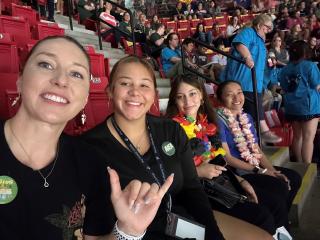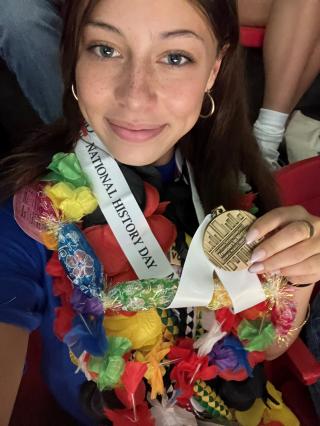Janay Fischer-Carter
Each year, students from around the country become historians as they participate in National History Day, a nation-wide competition where students deep dive into a topic of their choice and develop their communication, project management, and historical thinking skills along the way. As part of the national competition, the National Women’s History Museum sponsors the Women’s History prize, which is awarded to the best project in either division, in any category, that focuses on the contribution, accomplishments, experiences, and perspectives of women in U.S. history.

Meet one of the winner of the 2023 Women’s History Prizes, Janay Fischer-Carter (Hawai’i). She won for her individual performance, Wearing the Pants “9 to 5”: Expanding the Frontiers of Gender Equality. This past winter, we asked Janay to share her experience researching women’s stories.
Please Note: The below answers were transcribed from a video interview provided by Janay and edited for clarity by NWHM staff.
Can you tell us about your project? What was it about?
I went into the NHD competition looking to present a topic I found generally interesting but also that I thought wasn’t getting the coverage it deserved. Starting off with my school level, I completed an exhibit actually on the broad topic “women in pants,” which I enjoyed working on but as I moved up to district I had to work more with my strengths. I knew the exhibits were going to be the most popular category just looking around (at) my classmates. And also because, not to get too sad here, but even in 5th grade I had this very vivid memory talking about National History Day, like what a title, "National History Day." It felt so far off in the distance, talking about 9th graders winning it, and 12th graders and 11th graders, and I was only in 4th and 5th grade. In this memory, (I) was like, “Wow, I’m gonna be there one day. I know I can do it one day." And I did it. Which is why I keep repeating that this experience is so surreal because it has been a dream of mine for so long.
I was most strong at public speaking, so the obvious answer was to switch to the performance category instead of the exhibit, because there would be less people competing and I knew I would be stronger and ready to go like head to head with somebody. Because when you’re put in the competition rooms, it’s usually one performance (that) makes it out, so you have to be the best in your room, or you don’t move on. Even when I explain it, it sounds intimidating. When they were explaining it to us, it was extremely intimidating.

It was pretty challenging transitioning, especially when it came to writing the script and using my 10-minute performance time wisely. I kept going over to where I would have to cut so much stuff that I thought was critical and crucial to the progression of the story or it would be so far under to where it was just not using my time wisely. So, finding that sweet middle (time), 9:58 or 9:48 was kind of the most difficult part.
I remember being overwhelmed but not necessarily worried because I trusted myself to pull through and complete the assignment with quality. I’m used to high pressure situations and that’s when I usually work well or best so I feel like I could get it done and I was equipped for this kind of situation. So my project titled, “Wearing the Pants 9 to 5: Expanding the Frontiers of Gender Equality,” (which I still think is an extremely clever title), follows the ups and downs of Karen Nussbaum, a Boston secretary in the early 1970s and her best friend Ellen Cassedy, (and) what they experienced while helping found the 9to5 organization. The movement advocated for gender equality in the workplace and the wardrobe across the United States for decades more to come. I said, “more to come” because at the end of my performance in Washington, I said “the fight is not over,” and that is extremely true. Both Karen and Ellen are continuing to fight and so are women today. The fight isn’t over.
Why did you choose to tell a story that centered women’s history?
This was such an interesting question. Probably the most difficult to condense, but my choice to write and perform a story about gender equality was based on a plethora of things. For starters, my mom is in the Air Force, so as a woman in the Air Force you are immediately underestimated, even if you’re of higher rank. So it’s assumed you’re weaker, dumber, not as driven. I’m also in 9th grade and I play varsity football. Even in the 21st century, misogyny is so prevalent and I was told I couldn’t do it, it was a boy’s sport, girls were too fragile, weak and soft to play football. But that really only made me want to join more. A large part of my commitment was due to the fact that teachers, students and other people told me I couldn’t and I showed them I could. Which means all throughout childhood I’ve kind of seen women be oppressed for things that men were regularly celebrated for. And that beauty that comes with being a woman is uncanny and so incredibly taken advantage of, that this really encouraged me to capitalize on the female experience. And that’s why I shared this story because it was also something that was near and dear to my heart.
What is something surprising that you learned while working on this project?
While working on this project, I was dumbfounded to find that I had never heard of the 9to5 movement before. I didn’t even know about the organization, I didn’t even know about the 9 to 5 movement. And as someone who is so infatuated with history, and women’s rights especially, not knowing about this was such a shocker to me, an eye opener. The fact that I didn’t know about it, again someone who is infatuated with history, I made the correct assumption that most Americans, or most other people, don’t know about this story. Even though, despite the thousands of contributors, the media outlets they reached, and even the Netflix movie “9 to 5: the story of a movement,” it was still never something I’d heard about or even discussed in school. The effort women have put into this movement is so incredibly important in history because it greatly changed society’s views on gender equality. I chose to highlight women wearing pants because women have been oppressed through history via sexual harassment, unequal opportunity, pay, or even double standards. When fashion was used as a visible outlet to defy society’s misogynistic views regarding women.

And I get this question a lot, but why women in pants? What is the significance of the pants? Well, a lot of people don’t know this, but it used to be taboo for women to wear pants in America. And I believe before that it was illegal for women to actually wear pants in France, early France. So, why women wearing pants in America? When women started to wear pants again in America, it was a way of sharing with everyone around her that, "I think that men and women are equal, I think that I can do the same as men can do, I believe that because we are the same we deserve the same rights and we can do the same things." And that was an extremely bold statement for not just a woman, but anyone to make back then, because it was so ingrained in society that men are the head of the household, men are the guys who work jobs, and they’re caretakers, and women are always under them. So by stepping it up, it was different, and again, like I said, taboo. That’s why I decided to hone in on the pants aspect because I thought that it was extremely interesting, just starting small, working with something that only you can control. It’s like when counselors or friends tell you, "Hey, you can’t control what they think, you can’t control how they feel, focus on what you think, how you react, it’s not how they act but how you react." It’s intriguing that they really thought about that, instead of lashing out or doing something else. It’s such a simple but powerful statement and it really stuck with me, which is why I decided to make it a focal point in my project.
